This document summarizes the conclusions of an expert panel convened by the International Association of Gerontology and Geriatrics to discuss early detection of cognitive impairment. The panel agreed that:
1) Validated screening tests that take 3 to 7 minutes can identify early cognitive impairment.
2) The most effective approach is to use both patient-reported and informant-reported screening tools.
3) Early cognitive impairment may have treatable components, and emerging evidence supports interventions like medical treatment, nutrition changes, and physical/cognitive exercise to delay or reduce decline.
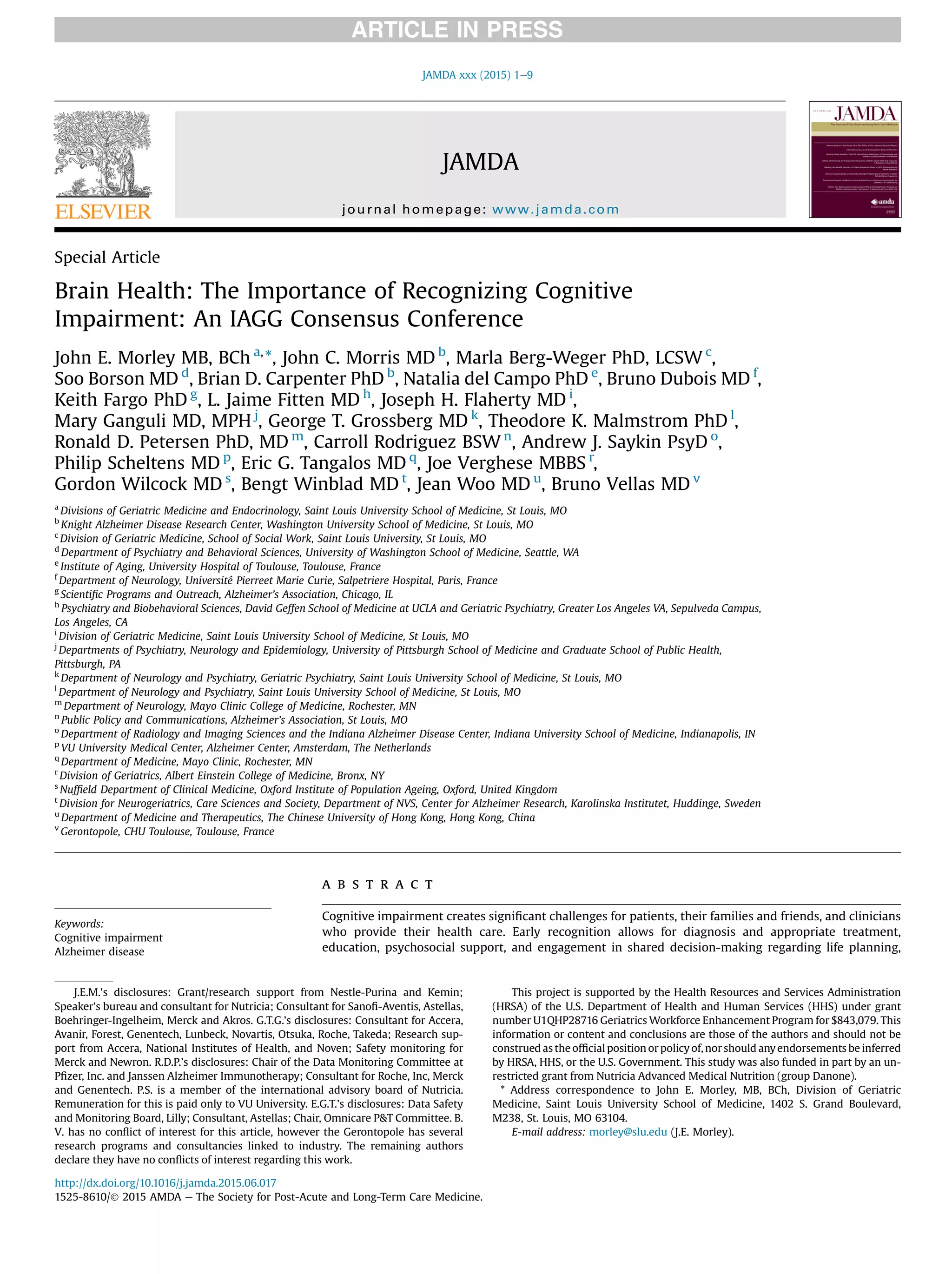
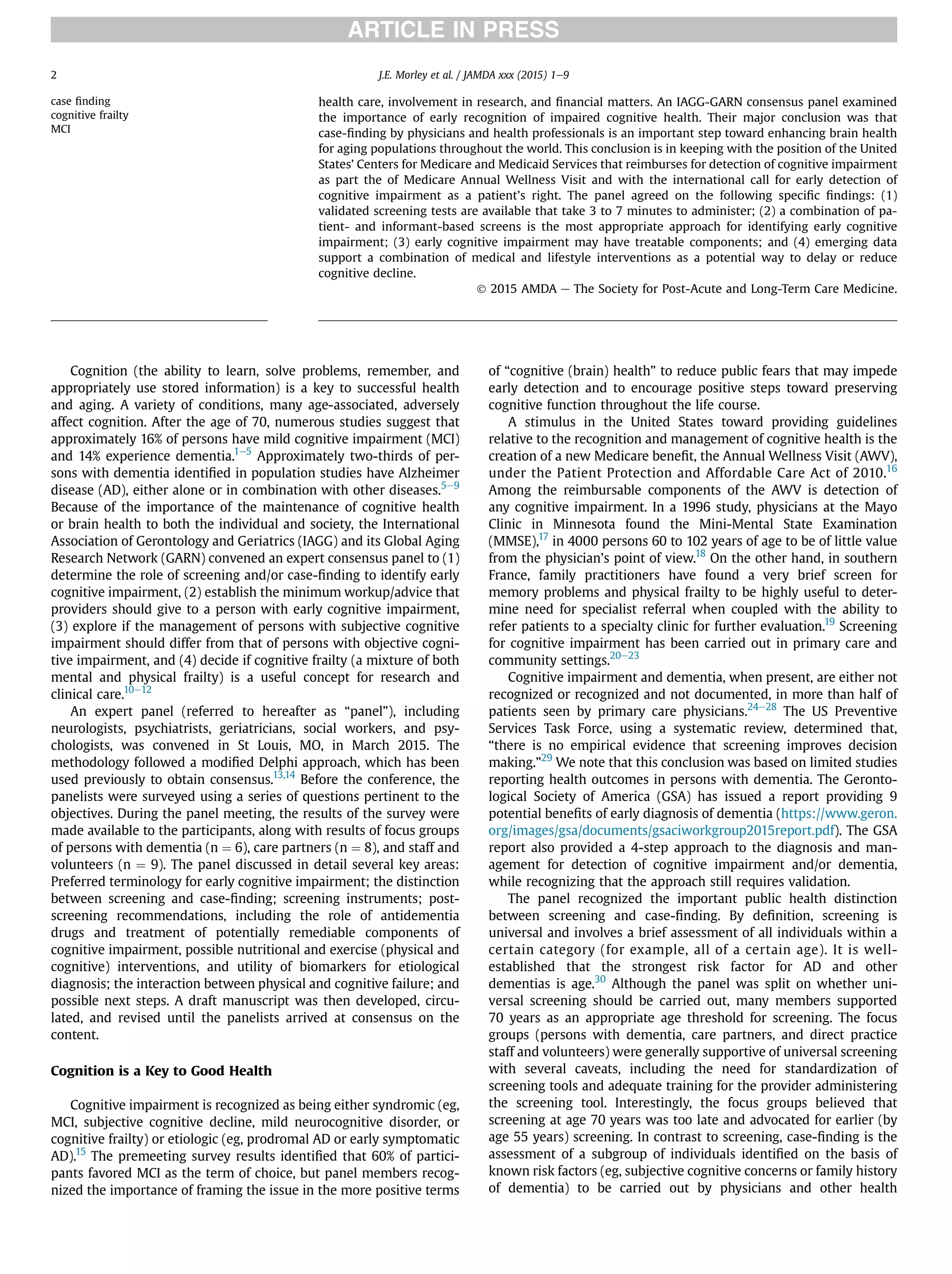

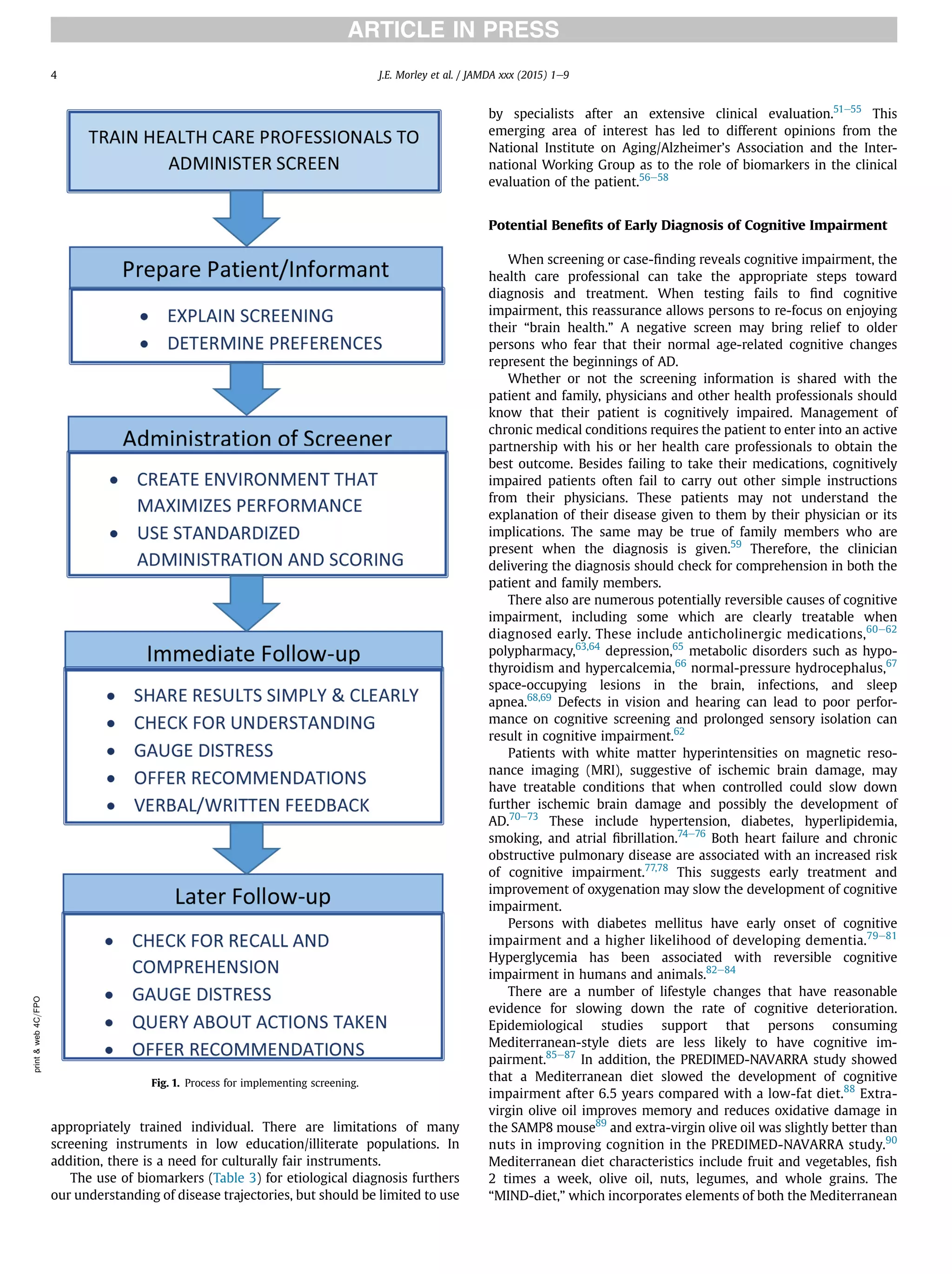
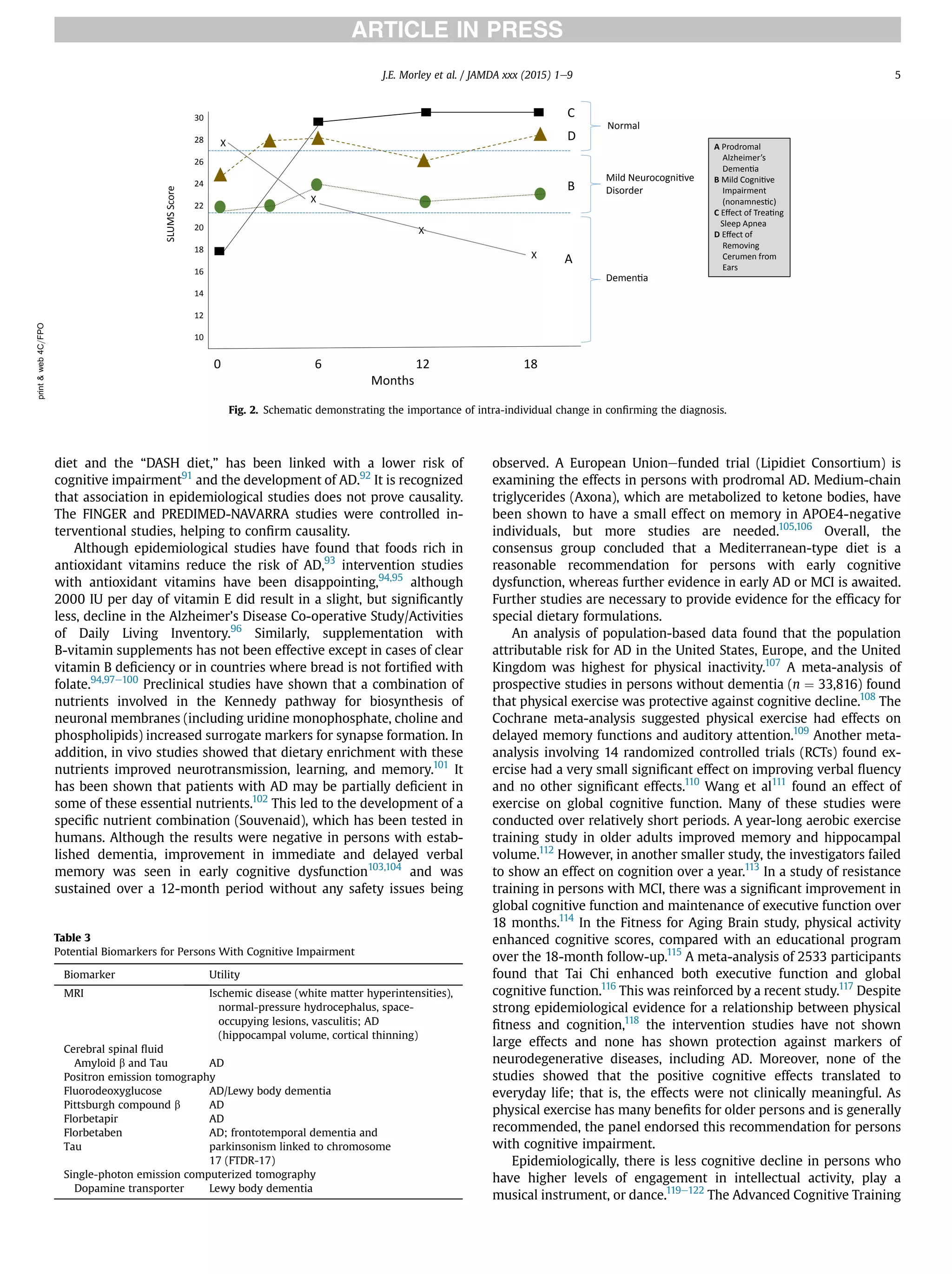
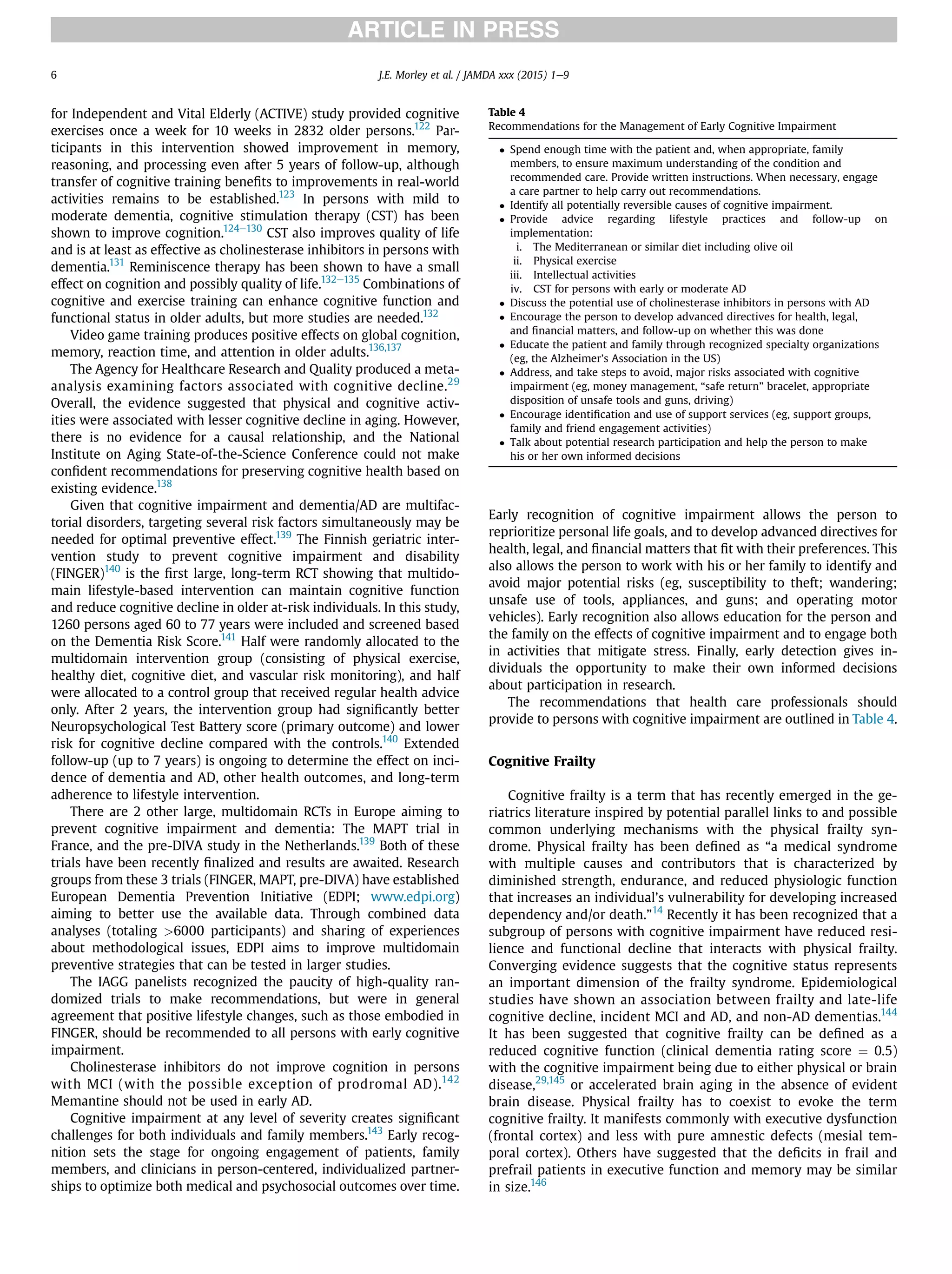
![There is some evidence that, even with normal aging, both
cognitive decline and physical frailty often coexist.147e149
Cross-
sectional studies find a high level of coexistence between rates of
cognitive impairment and dementia and physical frailty.150
Frailty
predicts cognitive decline and incident dementia,151,152
and cognitive
impairment predicts frailty153,154
in longitudinal studies. Loss of
executive function and poor attention are particularly associated with
slow gait.155
There is increasing evidence that persons with white
matter hyperintensities have poor balance, poor get up and go per-
formance, slow gait speed, and increased falls.156e158
White matter
hyperintensities also predict functional decline.159
The panelists agreed that persons with cognitive decline should be
screened for physical frailty and vice versa. Although the concept of
cognitive frailty may eventually yield useful insights and expanded
predictability of function and disease outcomes, the panelists, how-
ever, considered it premature to incorporate cognitive frailty into the
diagnostic lexicon and agreed that more studies on the interaction of
the 2 entities and their pathophysiology are needed.
Conclusion
There was consensus that all persons 70 years and older should
have their cognitive function (subjectively and objectively) evaluated
when visiting their health care provider, at least once a year. The
objectives of this assessment are to identify treatable disease, provide
lifestyle guidance to try to slow cognitive impairment, to allow
recognition of patients who may struggle understanding a physician’s
instructions, and to allow patients and their families to adequately
prepare if they are at risk for developing dementia. Although this will
vary by setting and circumstance, it was agreed that screening in-
struments should take less than 3 to 7 minutes to administer. The
need to follow an individual longitudinally (ie, serial assessments) to
demonstrate a deterioration in his or her performance was consid-
ered an important component of case-finding. The concept of
cognitive frailty was viewed as being of interest but needs further
research and development. The panel supports the Institute of
Medicine’s Report Brief that there is a need for a greater societal
commitment to promote cognitive health (http://www.iom.edu/
reports/2015/cognitive-aging.aspx). It is suggested that when
communicating with the public, the term “cognitive (brain) health”
may be more acceptable than talking about cognitive impairment or
dementia.
References
1. Petersen RC. Clinical practice. Mild cognitive impairment. N Engl J Med 2011;
364:2227e2234.
2. Morley JE. Mild cognitive impairmentda treatable condition. J Am Med Dir
Assoc 2014;15:1e5.
3. Winblad B, Palmer K, Kivipelto M, et al. Mild cognitive impairmentdbeyond
controversies, towards a consensus: Report of the International Working
Group on Mild Cognitive Impairment. J Intern Med 2004;256:240e246.
4. Ferri CP, Prince M, Brayne C, et al. Global prevalence of dementia: A Delphi
consensus study. Lancet 2005;366:2112e2117.
5. Hugo J, Ganguli M. Dementia and cognitive impairment: Epidemiology,
diagnosis, and treatment. Clin Geriatr Med 2014;30:421e442.
6. Tomlinson BE, Blessed G, Roth M. Observations on the brains of demented old
people. J Neurol Sci 1970;11:205e242.
7. Chui HC, Ramirez-Gomez L. Clinical and imaging features of mixed Alzheimer
and vascular pathologies. Alzheimers Res Ther 2015;7:21.
8. Zhang Y, Xu Y, Nie H, et al. Prevalence of dementia and major dementia
subtypes in the Chinese populations: A meta-analysis of dementia prevalence
surveys, 1980e2010. J Clin Neurosci 2012;19:1333e1337.
9. de Pedro-Cuesta J, Virues-Ortega J, Vega S, et al. Prevalence of dementia and
major dementia subtypes in Spanish populations: A re-analysis of dementia
prevalence surveys, 1990e2008. BMC Neurol 2009;9:55.
10. Kelaiditi E, Cesari M, Canevelli M, et al. Cognitive frailty: Rational and defi-
nition from an (I.A.N.A./I.A.G.G.) international consensus group. J Nutr Health
Aging 2013;17:726e734.
11. Malmstrom TK, Morley JE. Frailty and cognition: Linking two common syn-
dromes in older persons. J Nutr Health Aging 2013;17:723e725.
12. Fitten IJ. Thinking about cognitive frailty. J Prev Alzheimers Dis 2015;2:7e10.
13. Morley JE, Abbatecola AM, Argiles JM, et al. Sarcopenia with limited mobility:
An international consensus. J Am Med Dir Assoc 2011;12:403e409.
14. Morley JE, Vellas B, van Kan GA, et al. Frailty consensus: A call to action. J Am
Med Dir Assoc 2013;14:392e397.
15. Morris JC, Blennow K, Froelich L, et al. Harmonized diagnostic criteria for
Alzheimer’s disease: Recommendations. J Intern Med 2014;275:204e213.
16. Cordell CB, Borson S, Boustani M, et al. Alzheimer’s Association recommen-
dations for operationalizing the detection of cognitive impairment during the
Medicare Annual Wellness visit in a primary care setting. Alzheimers Dement
2013;9:141e150.
17. Folstein MF, Folstein SE, McHugh PR. “Mini-mental State.” A practical method
for grading the cognitive state of patients for the clinician. J Psychiatr Res
1975;12:189e198.
18. Tangalos EG, Smith GE, Ivnik RJ, et al. The Mini-Mental State Examination in
general medical practice: Clinical utility and acceptance. Mayo Clin Proc 1996;
71:829e837.
19. Subra J, Gillette-Guyonnet S, Cesari M, et al. The integration of frailty into
clinical practice: Preliminary results from the Gerontopole. J Nutr Health
Aging 2012;16:714e720.
20. McCarten JR, Anderson P, Kuskowski MA, et al. Screening for cognitive
impairment in an elderly veteran population: Acceptability and results using
different versions of the Mini-Cog. J Am Geriatr Soc 2011;59:309e313.
21. Bayley PJ, Kong JY, Mendiondo M, et al. Findings from the national memory
screening day program. J Am Geriatr Soc 2015;63:309e314.
22. Cruz-Oliver DM, Malmstrom TK, Allen CM, et al. The Veterans Affairs St. Louis
University mental status exam (SLUMS exam) and the Mini-mental status
exam as predictors of mortality and institutionalization. J Nutr Health Aging
2012;16:636e641.
23. Woo J, Yu R, Wong M, et al. Frailty screening in the community using the
FRAIL scale. J Am Med Dir Assoc 2015;16:412e419.
24. Ross GW, Abbott RD, Petrovitch H, et al. Frequency and characteristics of
silent dementia among elderly Japanese-American men. The Honolulu-Asia
Aging Study. JAMA 1997;277:800e805.
25. Jansen AP, van Hout HP, Nijpels G, et al. Yield of new method to detect
cognitive impairment in general practice. Int J Geriatr Psychiatry 2007;22:
590e597.
26. Miller DK, Morley JE, Rubenstein LZ, et al. Formal geriatric assessment in-
struments and the care of older general medical outpatients. J Am Geriatr Soc
1990;38:645e651.
27. Alzheimer’s Association. 2015 Alzheimer’s disease facts and figures. Available
at: www.alz.org/facts/overview.asp. Accessed March 29, 2015.
28. Tierney MC, Naglie G, Upshur R, et al. Factors associated with primary care
physicians’ recognition of cognitive impairment in their older patients.
Alzheimer Dis Assoc Disord 2014;28:320e325.
29. Lin JS, O’Connor E, Rossom RC, et al. Screening for cognitive impairment in
older adults: An evidence update for the U.S. Preventive services task force.
Agency for healthcare research and quality (US). 2013 (Nov) report No:14-
05198-EF-1. Available at: http://www.ncbi.nlm.nih.gov/pubmed/24354019.
Accessed March 25, 2015.
30. Imtiaz B, Tolppanen AM, Kivipelto M, Soininen H. Future directions in
Alzheimer’s disease from risk factors to prevention. Biochem Pharmacol 2014;
88:661e670.
31. Chin R, Ng A, Narasimhalu K, Kandiah N. Utility of the AD8 as a self-rating tool
for cognitive impairment in an Asian population. Am J Alzheimers Dis Other
Demen 2013;28:284e288.
32. Malmstrom TK, Miller DK, Coats MA, et al. Informant-based dementia
screening in a population-based sample of African Americans. Alzheimer Dis
Assoc Disord 2009;23:117e123.
33. Galvin JE, Roe CM, Powlishta KK, et al. The AD8: A brief informant interview to
detect dementia. Neurology 2005;65:559e564.
34. Galvin JE, Roe CM, Xiong C, Morris JC. Validity and reliability of the AD8
informant interview in dementia. Neurology 2006;67:1942e1948.
35. Rueda AD, Lau KM, Saito N, et al, Alzheimer’s Disease Neuroimaging Initiative.
Self-rated and informant-rated everyday function in comparison to objective
markers of Alzheimer’s disease [published online ahead of print November
15, 2014]. Alzheimers Dement; 2014. http://dx.doi.org/10.1016/j.jalz.2014.09.
002.
36. Meguro K, Kasai M, Nakamura K. Kurihara Project members. Reliability and
validity of the Japanese version of the AD8. Nihon Ronen Igakkai Zaashi 2015;
52:61e70.
37. Xie Y, Gao Y, Jia J, et al. Utility of AD8 for cognitive impairment in a Chinese
physical examination population: A preliminary study. ScientificWorldJournal
2014;2014:804871.
38. Chen CH, Wang LC, Ma TC, Yang YH. A walk-in screening of dementia in
the general population in Taiwan. ScientificWorldJournal 2014;2014:
243738.
39. Li T, Wang HL, Yang YH, et al. The reliability and validity of Chinese version of
AD8 [Chinese]. Zhonghua Nie Ke Za Zhi 2012;51:777e780.
40. Carnero Pardo C, de la Vega Cotarelo R, López Alcalde S, et al. Assessing the
diagnostic accuracy (DA) of the Spanish version of the informant-based AD8
questionnaire. Neurologia 2013;28:88e94.
J.E. Morley et al. / JAMDA xxx (2015) 1e9 7](https://image.slidesharecdn.com/iaggconsensus-170711082123/75/Brain-Health-The-Importance-of-Recognizing-Cognitive-Impairment-An-IAGG-Consensus-Conference-7-2048.jpg)
![41. Correia CC, Lima F, Junqueira F, et al. AD8-Brazil: Cross-cultural validation of
the ascertaining dementia interview in Portuguese. J Alzheimers Dis 2011;27:
177e185.
42. Borson S, Scanlan J, Brush M, et al. The mini-cog: A cognitive ‘vital signs’
measure for dementia screening in multi-lingual elderly. Int J Geriatr Psy-
chiatry 2000;15:1021e1027.
43. Scanlan J, Borson S. The Mini-Cog: Receiver operating characteristics with
expert and naïve raters. Int J Geriatr Psychiatry 2001;16:216e222.
44. Borson S, Scanlan JM, Chen P, Ganguli M. The Mini-Cog as a screen for de-
mentia: Validation in a population-based sample. J Am Geriatr Soc 2003;51:
1451e1454.
45. Setter SM, Neumiller JJ, Johnson M, et al. The mini-cog: A rapid dementia
screening tool suitable for pharmacists’ use. Consult Pharm 2007;22:855e861.
46. Tariq SH, Tumosa N, Chibnall JT, et al. Comparison of the Saint Louis Uni-
versity mental status examination and the mini-mental state examination for
detecting dementia and mild neurocognitive disorderda pilot study. Am J
Geriatr Psychiatry 2006;14:900e910.
47. Rapid Cognitive Screen (RCS): A point-of-care screening for dementia and
mild cognitive impairment. J Nutr Health Aging 2015;19:741e744.
48. Feliciano L, Horning SM, Klebe KJ, et al. Utility of the SLUMS as a cognitive
screening tool among a nonveteran sample of older adults. Am J Geriatr
Psychiatry 2013;21:623e630.
49. Cummings-Vaughn LA, Chavakula NN, Malmstrom TK, et al. Veterans Affairs
Saint Louis University mental status examination compared with the Mon-
treal cognitive assessment and the short test of mental status. J Am Geriatr
Soc 2014;62:1341e1346.
50. Dubois B, Touchon J, Portet F, et al. “The 5 words”: A simple and sensitive test
for the diagnosis of Alzheimer’s disease [French]. Presse Med 2002;31:
1696e1699.
51. Wicklund M, Petersen RC. Emerging biomarkers in cognition. Clin Geriatr Med
2013;29:809e828.
52. Morris JC, Kimberly A, Quaid K, et al. Role of biomarkers in studies of pre-
symptomatic Alzheimer’s disease. Alzheimers Dement 2005;1:145e151.
53. Ariza M, Kolb HC, Moechars D, et al. Tau positron emissions tomography (PET)
imaging: Past, present, and future. J Med Chem 2015;58:4365e4382.
54. McCleery J, Morgan S, Bradley KM, et al. Dopamine transporter imaging for
the diagnosis of dementia with Lewy bodies. Cochrane Database Syst Rev
2015;(1):CD010633.
55. Bocchetta M, Galluzzi S, Kehoe PG, et al. The use of biomarkers for the etio-
logic diagnosis of MCI in Europe: An EADC survey. Alzheimers Dement 2015;
11:195e206.e1.
56. McKhann GM, Knopman DS, Chertkow H, et al. The diagnosis of dementia due
to Alzheimer’s disease: Recommendations from the National Institute on
Aging-Alzheimer’s Association workgroups on diagnostic guidelines for Alz-
heimer’s disease. Alzheimers Dement 2011;7:263e269.
57. Prestia A, Caroli A, Wade SK, et al. Prediction of AD dementia by biomarkers
following the NIA-AA and IWG diagnostic criteria in MCI patients from three
European memory clinics [published online ahead of print January 31, 2015].
Alzheimers Dement; 2015. http://dx.doi.org/10.1016/j.jalz.2014.12.001.
58. Cummings JL, Dubois B, Molinuevo JL, Scheltens P. International Work Group
criteria for the diagnosis of Alzheimer disease. Med Clin North Am 2013;97:
363e368.
59. Zaleta AK, Carpenter BD, Porensky EK, et al. Agreement on diagnosis among
patients, companions, and professionals after a dementia evaluation.
Alzheimer Dis Assoc Disord 2012;26:232e237.
60. Morley JE. Anticholinergic medications and cognition. J Am Med Dir Assoc
2011;12:543e543.e1.
61. Campbell N, Boustani M, Limbil T, et al. The cognitive impact of anticholin-
ergics: A clinical review. Clin Inter Aging 2009;4:225e233.
62. Cruz-Oliver DM, Malmstrom TK, Roegner M, et al. Cognitive deficit reversal as
shown by changes in the Veterans Affairs Saint Louis University Mental Status
(SLUMS) examination scores 7.5 years later. J Am Med Dir Assoc 2014;15:687.
e5e687.e10.
63. Morandi A, Bellelli G, Vasilevskis EE, et al. Predictors of rehospitalization
among elderly patients admitted to a rehabilitation hospital: The role of
polypharmacy, functional status, and length of stay. J Am Med Dir Assoc 2013;
14:761e767.
64. Tsai R, Noone M, Johnson B, et al. Potentially inappropriate medication use in
individuals with mild cognitive impairment: Results from the Kerala Einstein
Study. J Am Geriatr Soc 2012;60:1369e1370.
65. Thakur M, Blazer DG. Depression in long-term care. J Am Med Dir Assoc 2008;
9:82e87.
66. Osterweil D, Syndulko K, Cohen SN, et al. Cognitive function in non-demented
older adults with hypothyroidism. J Am Geriatr Soc 1992;40:325e335.
67. Suchorska B, Kunz M, Schniepp R, et al. Optimized surgical treatment for
normal pressure hydrocephalus: Comparison between gravitational and dif-
ferential pressure valves. Acta Neurochir (Wien) 2015;157:703e709.
68. Olaithe M, Bucks RS. Executive dysfunction in OSA before and after treatment:
A meta-analysis. Sleep 2013;36:1297e1305.
69. Lal C, Strange C, Bachman D. Neurocognitive impairment in obstructive sleep
apnea. Chest 2012;141:1601e1610.
70. Van der Flier WM, van Straaten EC, Barkhof F, et al. Small vessel disease and
general cognitive function in nondisabled elderly: The LADIS study. Stroke
2005;36:2116e2120.
71. Kloppenborg RP, Nederkoorn PJ, Geerlings MI, van den Berg E. Presence and
progression of white matter hyperintensities and cognition: A meta-analysis.
Neurology 2014;82:2127e2138.
72. Overdorp EJ, Kessels RP, Claassen JA, Oosterman JM. Cognitive impairments
associated with medial temporal atrophy and white matter hyper-
intensities: An MRI study in memory clinic patients. Front Aging Neurosci
2014;6:98.
73. Wakefield DB, Moscufo N, Guttmann CR, et al. White matter hyperintensities
predict functional decline in voiding, mobility, and cognition in older adults.
J Am Geriatr Soc 2010;58:275e281.
74. Pantoni L. Cerebral small vessel disease: From pathogenesis and clinical
characteristics to therapeutic challenges. Lancet Neurol 2010;9:689e701.
75. Pantoni L, Poggesi A, Inzitari D. Cognitive decline and dementia related to
cerebrovascular diseases: Some evidence and concepts. Cerebrovasc Dis 2009;
27:191e196.
76. Ganguli M, Fu B, Snitz BE, et al. Mild cognitive impairment: Incidence and
vascular risk factors in a population-based cohort. Neurology 2013;80:
2112e2120.
77. Singh B, Mielke MM, Parsaik AK, et al. A prospective study of chronic
obstructive pulmonary disease and the risk for mild cognitive impairment.
JAMA Neurol 2014;71:581e588.
78. Ampadu J, Morley JE. Heart failure and cognitive dysfunction. Int J Cardiol
2015;178:12e23.
79. Cheng G, Huang C, Deng H, Wang H. Diabetes as a risk factor for dementia and
mild cognitive impairment: A meta-analysis of longitudinal studies. Intern
Med J 2012;42:484e491.
80. Geijselaers SL, Sep SJ, Stehouwer CD, Biessels GJ. Glucose regulation, and brain
MRI in type 2 diabetes: A systematic review. Lancet Diabetes Endocrinol
2015;3:75e89.
81. Biessels GJ, Reijmer YD. Brain changes underlying cognitive dysfunction in
diabetes: What can we learn from MRI? Diabetes 2014;63:2244e2252.
82. McNeilly GS, Cheung E, Tessier D, et al. The effect of improved glycemic
control on cognitive functions in the elderly patient with diabetes. J Gerontol
1993;48:M117eM121.
83. Reaven GM, Thompson LW, Nahum D, Haskins E. Relationship between hy-
perglycemia and cognitive function in older NIDDM patients. Diabetes Care
1990;13:16e21.
84. Flood JF, Mooradian AD, Morley JE. Characteristics of learning and memory in
streptozocin-induced diabetic mice. Diabetes 1990;39:1391e1398.
85. Psaltopoulou T, Sergentanis TN, Panagiotakos DB, et al. Mediterranean diet,
stroke, cognitive impairment, and depression: A meta-analysis. Ann Neurol
2013;74:580e591.
86. Singh B, Parsaik AK, Mielke MM, et al. Association of mediterranean diet with
mild cognitive impairment and Alzheimer’s disease: A systematic review and
meta-analysis. J Alzheimers Dis 2014;39:271e282.
87. Solfrizzi V, Panza F. Mediterranean diet and cognitive decline. A lesson from
the whole-diet approach: What challenges lie ahead? J Alzheimers Dis 2014;
39:283e286.
88. Martinez-Lapiscina EH, Clavero P, Toledo E, et al. Mediterranean diet im-
proves cognition: The PREDIMED-NAVARRA randomised trial. J Neurol Neu-
rosurg Psychiatry 2013;84:1318e1325.
89. Martinez-Lapiscina EH, Clavero P, Toledo E, et al. Virgin olive oil supple-
mentation and long-term cognition: The PREDIMED-NAVARRA randomized
trial. J Nutr Health Aging 2013;17:544e552.
90. Farr SA, Price TO, Dominguez LJ, et al. Extra virgin olive oil improves learning
and memory in SAMP8 mice. J Alzheimers Dis 2012;28:81e92.
91. Tangney CC, Li H, Wang Y, et al. Relation of DASH- and Mediterranean-like
dietary patterns to cognitive decline in older persons. Neurology 2014;83:
1410e1416.
92. Morris MC, Tangney CC, Wang Y, et al. MIND diet associated with reduced
incidence of Alzheimer’s disease [published online ahead of print February 11,
2015]. Alzheimers Dement; 2015. http://dx.doi.org/10.1016/j.jalz.2014.11.
009.
93. Barnard ND, Bush AI, Ceccarelli A, et al. Dietary and lifestyle guidelines for the
prevention of Alzheimer’s disease. Neurobiol Aging 2014;35:S74eS78.
94. Shah R. The role of nutrition and diet in alzheimer disease: A systematic re-
view. J Am Med Dir Assoc 2013;14:398e402.
95. Farina N, Isaac MG, Clark AR, et al. Vitamin E for Alzheimer’s dementia and
mild cognitive impairment. Cochrane Database Syst Rev 2012;(11):CD002854.
96. Dysken MW, Sano M, Asthana S, et al. Effect of vitamin E and memantine on
functional decline in Alzheimer disease: The TEAM-AD VA cooperative ran-
domized trial. JAMA 2014;311:33e44.
97. Li MM, Yu JT, Wang HF, et al. Efficacy of vitamin B supplementation on mild
cognitive impairment and Alzheimer’s disease: A systematic review and
meta-analysis. Curr Alzheimer Res 2014;11:844e852.
98. Dangour AD, Whitehouse PJ, Rafferty K, et al. B-Vitamins and fatty acids in the
prevention and treatment of Alzheimer’s disease and dementia: A systematic
review. J Alzheimers Dis 2010;22:205e224.
99. Malouf R, Areosa Sastre A. Vitamin B12 for cognition. Cochrane Database Syst
Rev 2003;(3):CD004326.
100. Cheng D, Kong H, Pang W, et al. B vitamin supplementation improves
cognitive function in the middle aged and elderly with hyper-
homocysteinemia [published online ahead of print June 18, 2014]. Nutr
Neurosci; 2014.
J.E. Morley et al. / JAMDA xxx (2015) 1e98](https://image.slidesharecdn.com/iaggconsensus-170711082123/75/Brain-Health-The-Importance-of-Recognizing-Cognitive-Impairment-An-IAGG-Consensus-Conference-8-2048.jpg)
![101. van Wijk N, Broersen LM, de Wilde MC, et al. Targeting synaptic dysfunction
in Alzheimer’s disease by administering a specific nutrient combination.
J Alzheimers Dis 2014;38:459e479.
102. Olde Rikkert MG, Verhey FR, Sijben JW, et al. Differences in nutritional status
between very mild Alzheimer’s disease patients and healthy controls.
J Alzheimers Dis 2014;41:261e271.
103. Shah RC, Kamphuis PJ, Leurgans S, et al. The S-Connect study: Results from a
randomized, controlled trial of souvenaid in mild-to-moderate Alzheimer’s
disease. Alzheimers Res Ther 2013;5:59.
104. Olde Rikkert MG, Verhey FR, Blesa R, et al. Tolerability and safety of souvenaid
in patients with mild Alzheimer’s disease: Results of multi-center, 24-week,
open-label extension study. J Alzheimers Dis 2015;44:471e480.
105. Sharma A, Bemis M, Desilets AR. Role of medium chain triglycerides (Axo-
na(R)) in the treatment of mild to moderate Alzheimer’s disease [published
online ahead of print January 9, 2014]. Am J Alzheimers Dis Other Demen;
2014.
106. Henderson ST, Vogel JL, Barr LJ, et al. Study of the ketogenic agent AC-1202 in
mild to moderate Alzheimer’s disease: A randomized, double-blind, placebo-
controlled, multicenter trial. Nutr Metab (Lond) 2009;6:31.
107. Norton S, Matthews FE, Barnes DE, et al. Potential for primary prevention of
Alzheimer’s disease: An analysis of population-based data. Lancet Neurol
2014;13:788e794.
108. Sofi F, Valecchi D, Bacci D, et al. Physical activity and risk of cognitive decline:
A meta-analysis of prospective studies. J Intern Med 2011;269:107e117.
109. Angevaren M, Aufdemkampe G, Verhaar HJ, et al. Physical activity and
enhanced fitness to improve cognitive function in older people without known
cognitive impairment. Cochrane Database Syst Rev 2008;(3):CD005381.
110. Gates N, Fiatarone Singh MA, Sachdev PS, Valenzuela M. The effect of exercise
training on cognitive function in older adults with mild cognitive impair-
ment: A meta-analysis of randomized controlled trials. Am J Geriatr Psychi-
atry 2013;21:1086e1097.
111. Wang C, Yu JT, Wang HF, et al. Non-pharmacological interventions for pa-
tients with mild cognitive impairment: A meta-analysis of randomized
controlled trials of cognition-based and exercise interventions. J Alzheimers
Dis 2014;42:663e678.
112. Erickson KI, Voss MW, Prakash RS, et al. Exercise training increases size of
hippocampus and improves memory. Proc Natl Acad Sci U S A 2011;108:
3017e3022.
113. Voss MW, Heo S, Prakash RS, et al. The influence of aerobic fitness on cerebral
white matter integrity and cognitive function in older adults: Results of a one-
year exercise intervention. Hum Brain Mapp 2013;34:2972e2985.
114. Fiatarone Singh MA, Gates N, Saigal N, et al. The study of mental and resis-
tance training (SMART) studydresistance training and/or cognitive training
in mild cognitive impairment: A randomized, double-blind, double-sham
controlled trial. J Am Med Dir Assoc 2014;15:873e880.
115. Lautenschlager NT, Cox KL, Flicker L, et al. Effect of physical activity on
cognitive function in older adults at risk for alzheimer disease: A randomized
trial. JAMA 2008;300:1027e1037.
116. Wayne PM, Walsh JN, Taylor-Piliae RE, et al. Effect of tai chi on cognitive
performance in older adults: Systematic review and meta-analysis. J Am
Geriatr Soc 2014;62:25e39.
117. Lam LC, Chau RC, Wong BM, et al. A 1-year randomized controlled trial
comparing mind body exercise (Tai Chi) while stretching and toning exercise
on cognitive function in older Chinese adults at risk of cognitive decline. J Am
Med Dir Assoc 2012;13:568.e15e568.e20.
118. Beydoun MA, Beydoun HA, Gamaldo AA, et al. Epidemiologic studies of
modifiable factors associated with cognition and dementia: Systematic
review and meta-analysis. BMC Public Health 2014;14:643.
119. Verghese J, Lipiton RB, Katz MJ, et al. Leisure activities and the risk of
dementia in the elderly. N Engl J Med 2003;348:2508e2516.
120. Verghese J, Wang Cuiling, Katz MJ, et al. Leisure activities and risk of vascular
cognitive impairment in older adults. J Geriatr Psychiatry Neurol 2009;22:
110e118.
121. Hall CB, Lipton RB, Sliwinski M, et al. Cognitive activities delay onset of
memory decline in persons who develop dementia. Neurology 2009;73:
356e361.
122. Unverzagt FW, Guey LT, Jones RN, et al. ACTIVE cognitive training and rates of
incident dementia. J Int Neuropsychol Soc 2012;18:669e677.
123. Jones RN, Marsiske M, Ball K, et al. The ACTIVE cognitive training in-
terventions and trajectories of performance among older adults. J Aging
Health 2013;25:186Se208S.
124. Woods B, Aguirre E, Spector AE, Orrell M. Cognitive stimulation to improve
cognitive functioning in people with dementia. Cochrane Database Syst Rev
2012;(2):CD005562.
125. Simon SS, Yokomizo JE, Bottino CMC. Cognitive intervention in amnestic mild
cognitive impairment: A systematic review. Neurosci Biobehav Rev 2012;36:
1163e1178.
126. D’Amico F, Rehill A, Knapp M, et al. Maintenance cognitive stimulation
therapy: An economic evaluation within a randomized controlled trial. J Am
Med Dir Assoc 2015;16:63e70.
127. Loraine J, Taylor S, McAllister M. Cognitive and physical stimulation therapy.
J Am Med Dir Assoc 2014;15:140e141.
128. Kawashima R, Hiller DL, Sereda SL, et al. SAIDO learning as a cognitive
intervention for dementia care: A preliminary study. J Am Med Dir Assoc
2015;16:56e62.
129. Karlin BE, Visnic S, McGee JS, Teri L. Results from the multisite implementa-
tion of STAR-VA: A multicomponent psychosocial intervention for managing
challenging dementia-related behaviors of veterans. Psychol Serv 2014;11:
200e208.
130. Teri L, Huda P, Gibbons L, et al. STAR: A dementia-specific training program
for staff in assisted living residencies. Gerontologist 2005;45:686e693.
131. Woods B, Thorgrimsen L, Spector A, et al. Improved quality of life and cognitive
stimulation therapy in dementia. Aging Ment Health 2006;10:219e226.
132. Law LLF, Barnett F, Yau MK, Gray MA. Effects of combined cognitive and
exercise interventions on cognition in older adults with and without cogni-
tive impairment: A systematic review. Ageing Res Rev 2014;15:61e75.
133. Wingbermuehle C, Bryer D, Berg-Weger M, et al. Baseball reminiscence
league: A model for supporting persons with dementia. J Am Med Dir Assoc
2014;15:85e89.
134. van Bogaert P, Van Grinsven R, Tolson D, et al. Effects of SolCos model-based
individual reminiscence on older adults with mild to moderate dementia
due to alzheimer disease: A pilot study. J Am Med Dir Assoc 2013;14:528.
e9e528.e13.
135. Woods B, Spector A, Jones C, et al. Reminiscence therapy for dementia.
Cochrane Database Syst Rev 2005;(2):CD001120.
136. Toril P, Reales JM, Ballesteros S. Video game training enhances cognition of
older adults: A meta-analytic study. Psychol Aging 2014;29:706e716.
137. Kueider AM, Parisi JM, Gross AL, Rebok GW. Computerized cognitive training
with older adults: A systematic review. PLoS One 2012;7:e40588.
138. Daviglus ML, Bell CC, Berrettini W, et al. National Institutes of Health State-of-
the-Science Conference statement: Preventing Alzheimer disease and cogni-
tive decline. Ann Intern Med 2010;153:176e181.
139. Solomon A, Mangialasche F, Richard E, et al. Advances in the prevention of
Alzheimer’s disease and dementia. J Intern Med 2014;275:229e250.
140. Ngandu T, Lehtisalo J, Solomon A, et al. A 2 year multidomain intervention of
diet, exercise, cognitive training, and vascular risk monitoring versus control
to prevent cognitive decline in at-risk elderly people (FINGER): A randomized
controlled trial. Lancet 2015;385:2255e2263.
141. Kivipelto M, Ngandu T, Laatikainen T, et al. Risk score for the prediction of
dementia risk in 20 years among middle aged people: A longitudinal,
population-based study. Lancet Neurol 2006;5:735e741.
142. Knopman DS, Petersen RC. Mild cognitive impairment and mild dementia: A
clinical perspective. Mayo Clin Proc 2014;89:1452e1459.
143. Dean K, Wilcock G. Living with mild cognitive impairment: The patient’s and
carer’s experience. Int Psychogeriatr 2012;24:871e881.
144. Panza F, Solfrizzi V, Barulli MR, et al. Cognitive frailtydepidemiological and
neurobiological evidence of an age-related clinical condition: A systematic
review [published online ahead of print March 26, 2015]. Rejuvenation Res;
2015.
145. Morris JC. The clinical dementia rating (CDR): Current version and scoring
rules. Neurology 1993;43:2412e2414.
146. Robertson DA, Savva BM, Coen RF, Kenny RA. Cognitive function in the pre-
frailty and frailty syndrome. J Am Geriatr Soc 2014;62:2118e2124.
147. Malmstrom TK, Morley JE. The frail brain. J Am Med Dir Assoc 2013;14:
453e455.
148. Shimada H, Makizako H, Doi T, et al. Combined prevalence of frailty and mild
cognitive impairment in a population of elderly Japanese people. J Am Med
Dir Assoc 2013;14:518e524.
149. Nishiguchi S, Yamada M, Fukutani N, et al. Differential association of frailty
with cognitive decline and sarcopenia in community-dwelling older adults.
J Am Med Dir Assoc 2015;16:120e124.
150. Mitnitski A, Fallah N, Rockwood MR, Rockwood K. Transitions in cognitive
status in relation to frailty in older adults: A comparison of three frailty
measures. J Nutr Health Aging 2011;15:863e867.
151. Avila-Funes JA, Pina-Escudero SD, Aguilar-Navarro S, et al. Cognitive impair-
ment and low physical activity are the components of frailty more strongly
associated with disability. J Nutr Health Aging 2011;15:683e689.
152. Auyeung TW, Lee JS, Kwok T, Woo J. Physical frailty predicts future cognitive
declineda four-year prospective study in 2737 cognitively normal older
adults. J Nutr Health Aging 2011;15:690e694.
153. Parihar R, Mahoney JR, Verghese J. Relationship of gait and cognition in the
elderly. Curr Transl Geriatr Exp Gerontol Rep 2013;2.
154. Halil M, Cemal Kizilarslanoglu M, Emin Kuyumcu M, et al. Cognitive aspects of
frailty: Mechanisms behind the link between frailty and cognitive impair-
ment. J Nutr Health Aging 2015;19:276e283.
155. McCough EL, Kelly VE, Logsdon RG, et al. Associations between physical
performance and executive function in older adults with mild cognitive
impairment: Gait speed and the timed “up go” test. Phys Ther 2011;91:
1198e1207.
156. Ogama N, Sakurai T, Shimizu A, Toba K. Regional white matter lesions predict
falls in patients with amnestic mild cognitive impairment and Alzheimer’s
disease. J Am Med Dir Assoc 2014;15:36e41.
157. Bolandzadeh N, Liu-Ambrose T, Aizenstein H, et al. Pathways linking
regional hyperintensities in the brain and slower gait. Neuroimage 2014;
99:7e13.
158. Callisaya ML, Beare R, Phan T, et al. Progression of white matter hyper-
intensities of presumed vascular origin increases the risk of falls in older
people. J Gerontol A Biol Sci Med Sci 2015;70:358e364.
159. Prins ND, Scheltens P. White matter hyperintensities, cognitive impairment
and dementia: An update. Nat Rev Neurol 2015;11:157e165.
J.E. Morley et al. / JAMDA xxx (2015) 1e9 9](https://image.slidesharecdn.com/iaggconsensus-170711082123/75/Brain-Health-The-Importance-of-Recognizing-Cognitive-Impairment-An-IAGG-Consensus-Conference-9-2048.jpg)